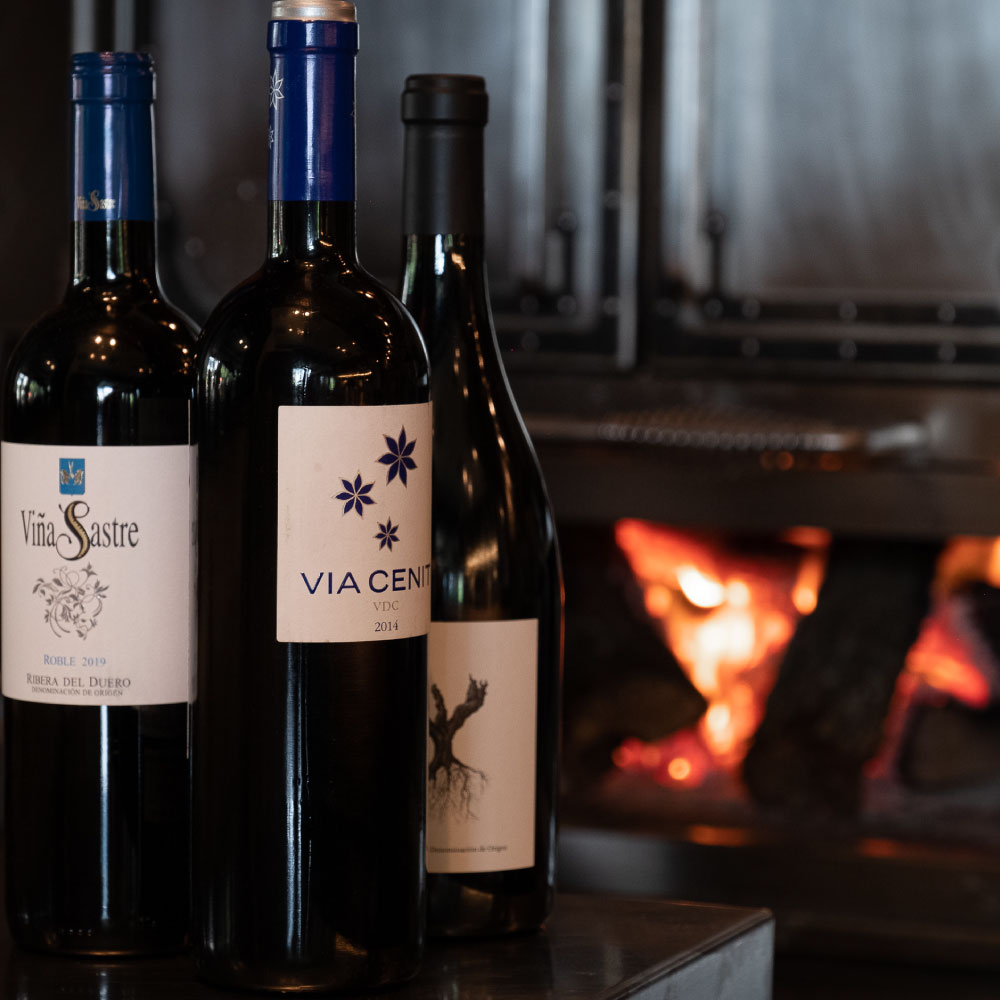When evening descends earlier than it did just a few weeks before; when dry autumn leaves fall to the ground and the sounds of swoosh and snap fill the air as the wind whips through; and when fireplaces, wood-fired ovens, and stoves emit warmth and light and power once again, “crackle” becomes the sound of autumn.
That’s why in Spain’s Ribera del Duero and Rueda – two areas that get bitterly cold as the sun journeys farther away – people come together in places where a roaring fire is doing more than simply emitting warmth. Its flame is transforming the local specialties, lechazo and cochinillo, into sizzling fat and tender meat with rich juices that only suckling lamb and pig can offer. Fire is a key element to tradition in Castilla y Leon, and together with countless other dishes, creates a food culture and ambiance in which drinking the local wines is as integral to the gathering as air itself.
The locals from Castilla y Leon drink Verdejo from Rueda and Tempranillo from Ribera. Grown in a variety of soil types along the Duero River and at several altitudes, the grapes’ fight for survival is informed by hundreds of years of desire and hard work by locals to create the perfect glass. Together, these elements call for toasts with friends and simplistic fire-cooked fare to sip and savor together – and maybe a whisper of gratitude alongside.
Verdejo, and its wide range of styles from the aperitif to the decanter, and Tempranillo, a medium- to full-bodied wine redolent of dark fruits and earthy depth, always contain fruit balanced by inherent acidity. White wines like Rueda’s Verdejo are matched with the grilled fish the Basque fisherman brings to port, and Tempranillo loves wood-fire cooking of all kinds.
Fire’s early days in Spain reaches the world
Fire cooking is primal. It not only paved the way for no less than the evolution of humans – the discovery of fire allowed for the cooking of a higher-quality diet of roots, grasses, and animals, which in turn fueled brain size – but throughout time, fires themselves have served another purpose: social gatherings and community. The discovery of controlled fire may have led the hominids – early humans and apes – to gather around fires, stay up later, socialize and establish local culture.
In Spain, fire has played a central role in the food culture, though perhaps no more so than in Spain’s Basque country. Here, fire is no less than the soul itself. Embodying this is Chef Bittor Arguinzoniz, whose dedication to live-fire cooking continually lands his 33-year-old Michelin-starred restaurant Asador Extebarri on top restaurant lists in the world. As fundamental as fire is to survival, Arguinzoniz elevates it to an art form, converting food into delicious brilliance all with one common tie: fire.
Live-fire cooking methods take several forms in Spain – hoguera or hearth, parilla or grill (or grate), brasa or hot coals, and plancha – a hot plate set over coals. Historically, people in Castilla y Leon’s Ribera del Duero and Rueda regions took a nod from their Basque neighbors and utilized vine roots to create fire fuel. Pilgrims journeying along the Camino de Santiago nabbed quail, wrapped them in grape leaves, and roasted them over the fire. Valencians depended on orangewood prunings to fuel paella fires. And so it went – whatever fuel was readily available was gathered and used.
This included the fire fuel the Basque fishermen brought with them to cook with on their ships as well as forage for wherever they landed. One such landing was Argentina, where locals picked up the Basque art of the asador – grill cooking – and made it their own. Indeed, Argentina’s culinary reputation is now inextricably linked to live-fire cooking not just there but in other countries too. By the 1800’s, asador cooking was expanding worldwide as German gemstone prospectors in Argentina became captivated by this technique from South American gauchos. It was only a matter of time before Germans adapted the cooking method in their home country.
At about the same time the Basques reached South America, other Spaniards were landing in the Caribbean. Here, island natives observed these newcomers’ cooking method, which consisted of meat being cooked slowly on a wooden platform set over a flame. The word used to describe this type of cooking came from the Taino, a Caribbean Indian tribe. Their word: barabicu. The Spaniards’ translation: barbacoa. The English word? Barbecue.
Fire is community
Thankfully some things never change, and the practice of gathering around a fire is one of those. In fact, the communal draw to fire may be more fundamental to being human than we think. In Latin, the words fireplace or hearth mean focus. When we gather around a fire, that fire is the locus (and focus) of our attention. We are centered, maybe even transfixed.
That glass of wine we may be holding also begs for attention as we remember it too emanates from the ground and follows a journey of its own before reaching our palates. The only difference between wine and the fire that captivates us is that the making of the wine is fueled by desire and the drinking of it fuels desire. Both are endlessly drawn together by romance and the art of communication.



